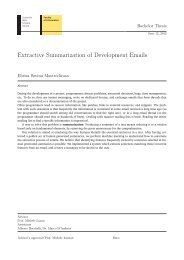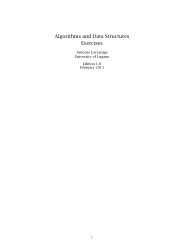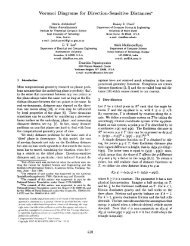Barycentric coordinates and transfinite interpolation
Barycentric coordinates and transfinite interpolation
Barycentric coordinates and transfinite interpolation
Create successful ePaper yourself
Turn your PDF publications into a flip-book with our unique Google optimized e-Paper software.
<strong>Barycentric</strong> <strong>coordinates</strong> <strong>and</strong> <strong>transfinite</strong><br />
<strong>interpolation</strong><br />
Michael Floater<br />
Centre of Mathematics for Applications,<br />
Department of Informatics,<br />
University of Oslo
In this talk:<br />
1. <strong>Barycentric</strong> <strong>coordinates</strong><br />
2. Generalization to polygons: Wachspress, mean value, etc.<br />
3. Transfinite <strong>interpolation</strong>
<strong>Barycentric</strong> <strong>coordinates</strong> on a triangle<br />
v 3<br />
T<br />
x<br />
v 1<br />
v 2<br />
Given x ∈ T , want λ 1 , λ 2 , λ 3 ≥ 0 such that<br />
λ 1 + λ 2 + λ 3 = 1,<br />
<strong>and</strong><br />
λ 1 v 1 + λ 2 v 2 + λ 3 v 3 = x.
Linear system of three equations,<br />
⎛ ⎞ ⎛ ⎞ ⎛ ⎞<br />
1 1 1 λ 1 1<br />
⎝v1 1 v2 1 v3<br />
1 ⎠ ⎝λ 2<br />
⎠ = ⎝x 1 ⎠ .<br />
v1 2 v2 2 v3<br />
2 λ 3 x 2<br />
By Cramer’s rule, unique solution is<br />
λ 1 = A 1<br />
A , λ 2 = A 2<br />
A , λ 3 = A 3<br />
A .<br />
v 3<br />
A<br />
A 2<br />
x<br />
A 3<br />
A 1<br />
v 1<br />
v 2
Properties<br />
◮ Lagrange property: λ i (v j ) = δ ij .<br />
◮ Interpolation: if<br />
g(x) =<br />
3∑<br />
λ i (x)f (v i ),<br />
i=1<br />
then g(v i ) = f (v i ).<br />
◮ Linear precision: if f is linear then g = f .<br />
◮ Linearity: λ i is linear.<br />
◮ Bernstein-Bezier basis for polynomials, degree d:<br />
p(x) =<br />
∑<br />
i+j+k=d<br />
n!<br />
i!j!k! λi 1(x)λ j 2 (x)λk 3(x)c ijk .
<strong>Barycentric</strong> <strong>coordinates</strong> on polygons<br />
Let Ω be a convex polygon.<br />
v 4<br />
v 3<br />
v 5<br />
v 1 v 2<br />
Functions λ i : Ω → R, i = 1, . . . , n, are barycentric <strong>coordinates</strong> if<br />
for x ∈ Ω, λ i (x) ≥ 0, i = 1, . . . , n, <strong>and</strong><br />
n∑<br />
λ i (x) = 1,<br />
i=1<br />
n∑<br />
λ i (x)v i = x.<br />
i=1
Properties<br />
◮ Lagrange property: λ i (v j ) = δ ij .<br />
◮ Interpolation: if<br />
n∑<br />
g(x) = λ i (x)f (v i ),<br />
i=1<br />
then g(v i ) = f (v i ).<br />
◮ Linear precision: if f is linear then g = f .<br />
◮ λ i lies between the two functions:<br />
1<br />
1<br />
0<br />
0<br />
0<br />
0<br />
0<br />
0<br />
◮ Generalized Bernstein-Bezier:<br />
p(x) = ∑ ( ) d<br />
λ i 1<br />
i 1<br />
(x) · · · λ in n (x)c i .<br />
|i|=d<br />
0<br />
0<br />
0<br />
0
Coordinates for quadrilaterals<br />
v 01<br />
v 11<br />
x<br />
v 00<br />
v 10<br />
Can find λ, µ ∈ [0, 1] s.t.<br />
x = (1 − λ)(1 − µ)v 00 + λ(1 − µ)v 10 + (1 − λ)µv 01 + λµv 11 ,<br />
giving an interpolant<br />
g(x) = (1 − λ)(1 − µ)f 00 + λ(1 − µ)f 10 + (1 − λ)µf 01 + λµf 11 .
To find λ <strong>and</strong> µ: let<br />
a = v 00 −x, b = v 10 −v 00 , c = v 01 −v 00 , d = v 00 −v 10 −v 01 +v 11 .<br />
Then need to solve<br />
a + bλ + cµ + dλµ = 0.<br />
Eliminating λ gives a quadratic in µ:<br />
(a + cµ) × (b + dµ) = 0.<br />
Similar for λ. The special cases c × d = 0 <strong>and</strong> b × d = 0 need to<br />
be treated separately.
Wachspress <strong>coordinates</strong>: Wachspress 1973, Warren 1996<br />
v i+1<br />
x<br />
v i<br />
v i−1<br />
For a convex polygon, n vertices, let<br />
λ i (x) =<br />
w i (x)<br />
∑ n<br />
j=1 w j(x) , w i(x) =<br />
Then λ 1 , . . . , λ n are barycentric <strong>coordinates</strong>.<br />
A(v i−1 , v i , v i+1 )<br />
A(x, v i−1 , v i )A(x, v i , v i+1 ) .
Proof: Meyer et al. 2002<br />
Let<br />
A i = A(x, v i , v i+1 ) <strong>and</strong> B i = A(v i−1 , v i , v i+1 ).<br />
Then express x as<br />
<strong>and</strong> rearrange:<br />
x = A i<br />
v i−1 + (B i − A i−1 − A i )<br />
v i + A i−1<br />
v i+1 ,<br />
B i B i<br />
B i<br />
B i<br />
(v i − x) = 1 (v i − v i−1 ) − 1 (v i+1 − v i ).<br />
A i−1 A i A i−1 A i<br />
Summing both sides over i gives<br />
∑ B i<br />
(v i − x) = 0<br />
A i−1 A i<br />
or<br />
i<br />
∑<br />
w i (x)(v i − x) = 0.<br />
i
Wachspress <strong>coordinates</strong> are rational<br />
λ i (x) =<br />
B i<br />
∑<br />
k B k<br />
∏<br />
j≠i−1,i A j(x)<br />
∏<br />
j≠k−1,k A j(x)<br />
=<br />
degree (n − 2)<br />
degree (n − 3) .
Application: barycentric mappings<br />
Recipe: given x ∈ Ω,<br />
1. express x in Wachspress form x = ∑ i λ i(x)v i ,<br />
2. set x ′ = ∑ i λ i(x)v ′ i .
Application: curve deformation
Theorem (F. & Kosinka). Wachspress mappings are injective<br />
Idea of proof: express Jacobian as<br />
∣<br />
∑<br />
λ i λ j λ k ∣∣∣∣∣<br />
J = 2<br />
∂ 1 λ i ∂ 1 λ j ∂ 1 λ k A(v i, ′ v j, ′ v k ′<br />
1≤i
Mean value <strong>coordinates</strong><br />
v i+1<br />
v i<br />
x<br />
α i<br />
α i−1<br />
v i−1<br />
For a convex polygon, n vertices, let λ i (x) = w i (x)/ ∑ n<br />
j=1 w j(x),<br />
where<br />
w i (x) =<br />
(<br />
1<br />
tan<br />
‖v i − x‖<br />
(<br />
αi−1 (x)<br />
2<br />
)<br />
+ tan<br />
Then λ 1 , . . . , λ n are barycentric <strong>coordinates</strong>.<br />
(<br />
αi (x)<br />
2<br />
))<br />
.
Proof:<br />
With e i = (v i − x)/‖v i − x‖, need to show that<br />
or<br />
n∑ (<br />
tan(αi−1 /2) + tan(α i /2) ) e i = 0,<br />
i=1<br />
n∑<br />
tan(α i /2)(e i + e i+1 ) = 0. (1)<br />
i=1<br />
To show this, let e i = (cos θ i , sin θ i ). Then α i = θ i+1 − θ i , <strong>and</strong> so<br />
( αi<br />
)<br />
( αi<br />
)<br />
tan (e i + e i+1 ) = tan (cos θ i + cos θ i+1 , sin θ i + sin θ i+1 )<br />
2<br />
2<br />
= (sin θ i+1 − sin θ i , cos θ i − cos θ i+1 ).<br />
Summing this over i = 1, . . . , n gives (1).
Application: mesh parameterization
Transfinite <strong>interpolation</strong>, Warren et al 2004<br />
c ( t i+1 )<br />
c ( t i)<br />
For convex curve c : [a, b] → R 2 sample points v i = c(t i ) <strong>and</strong> take<br />
limit of Wachspress interpolants as max i (t i+1 − t i ) → 0. Gives a<br />
‘<strong>transfinite</strong> interpolant’<br />
∫ /<br />
b<br />
∫ b<br />
g(x) = w(x, t)f (c(t)) dt w(x, t) dt,<br />
a<br />
where w(x, t) = (c ′ (t) × c ′′ (t))/((c(t) − x) × c ′ (t)) 2 .<br />
a
MV <strong>transfinite</strong> <strong>interpolation</strong><br />
c ( t i+1 )<br />
c ( t i)<br />
Analogously, the <strong>transfinite</strong> MV interpolant is<br />
∫ /<br />
b<br />
∫ b<br />
g(x) = w(x, t)f (c(t)) dt w(x, t) dt,<br />
a<br />
a<br />
where<br />
w(x, t) = (c(t) − x) × c′ (t)<br />
‖c(t) − x‖ 3 .
Examples of MV interpolants
Non-convex curves? Angle formulation<br />
p ( x, θ)<br />
x<br />
θ<br />
For a convex curve, the MV interpolant is<br />
g(x) =<br />
∫ 2π<br />
0<br />
/ ∫<br />
f (p(x, θ))<br />
2π<br />
‖p(x, θ) − x‖ dθ 1<br />
‖p(x, θ) − x‖ dθ.<br />
0
On arbitrary curves<br />
p ( x, θ)<br />
2<br />
p 3<br />
( x, θ)<br />
p 1<br />
( x, θ)<br />
x<br />
θ<br />
where<br />
g(x) =<br />
∫ 2π<br />
0<br />
n(x,θ)<br />
∑<br />
j=1<br />
φ(x) =<br />
Hormann: φ(x) > 0.<br />
/<br />
(−1) j−1<br />
‖p j (x, θ) − x‖ f (p j(x, θ)) dθ φ(x),<br />
∫ 2π<br />
0<br />
n(x,θ)<br />
∑<br />
j=1<br />
(−1) j−1<br />
‖p j (x, θ) − x‖ dθ.
Application: image warping, Hormann
Application: mesh deformation, Ju, Schaefer, Warren
Hermite <strong>interpolation</strong><br />
Two methods:<br />
◮ Use MV weight function (with Chris Dyken / Solveig Bruvoll)<br />
◮ Radial minimization (with Christian Schulz)
Method 1: weight function<br />
The cubic interpolant p to the data f (0), f ′ (0), f (1), f ′ (1), can be<br />
expressed as<br />
p(x) = g 0 (x) + ψ(x)g 1 (x),<br />
where<br />
g 0 (x) = (1 − x)f (0) + xf (1),<br />
ψ(x) = x(1 − x),<br />
g 1 (x) = (1 − x)m 0 + xm 1 ,<br />
<strong>and</strong><br />
m 0 = f ′ (0) − f (1) + f (0), m 1 = −f ′ (1) + f (1) − f (0).
In R n we interpolate the data f <strong>and</strong> ∂f<br />
∂n<br />
on ∂Ω by the function<br />
p(x) = g 0 (x) + ψ(x)g 1 (x), x ∈ Ω,<br />
where<br />
<strong>and</strong><br />
m(y) =<br />
∫<br />
/<br />
f (p(x, v))<br />
g 0 (x) =<br />
S ‖p(x, v) − x‖ dv φ(x),<br />
/<br />
ψ(x) = 1 φ(x),<br />
∫<br />
g 1 (x) =<br />
S<br />
/<br />
m(p(x, v))<br />
‖p(x, v) − x‖ dv φ(x),<br />
∫<br />
φ(x) =<br />
1<br />
‖p(x, v) − x‖ dv.<br />
S<br />
( ∂f<br />
∂n (y) − ∂g 0<br />
∂n (y) ) / ∂ψ<br />
∂n (y),<br />
y ∈ ∂Ω.
To use this construction we need to find ∂ψ<br />
∂n (y) <strong>and</strong> ∂g 0<br />
∂n (y).<br />
Theorem<br />
If d(M E , ∂Ω) > 0 <strong>and</strong> d(M I , ∂Ω) > 0 <strong>and</strong> y ∈ ∂Ω then<br />
∂ψ<br />
∂n (y) = 1 ,<br />
V n−1<br />
∂g 0<br />
∂n (y) = 1 f (p(y, v)) − f (y)<br />
V n−1<br />
∫H(n) ‖p(y, v) − y‖<br />
dv,<br />
where V n−1 is the volume of the unit sphere in R n−1 : V 1 = 2,<br />
V 2 = π, V 3 = 4π/3, V 4 = π 2 /2,...
Hermite examples
Method 2: radial minimization<br />
MV <strong>interpolation</strong> revisited: the value g(x) is the unique minimizer<br />
a = g(x) of the local ‘energy’ function<br />
where<br />
∫<br />
E x (a) =<br />
q x,v (r) =<br />
<strong>and</strong> ρ(x, v) = ‖p(x, v) − x‖.<br />
S<br />
∫ ρ(x,v)<br />
0<br />
(<br />
q<br />
′<br />
x,v (r) ) 2 dr dv,<br />
ρ(x, v) − r<br />
a +<br />
r f (p(x, v)),<br />
ρ(x, v) ρ(x, v)
Hermite <strong>interpolation</strong><br />
Find a ∈ R <strong>and</strong> b ∈ R n that minimize<br />
∫ ∫ ρ(x,v) (<br />
E x (a, b) =<br />
q<br />
′′<br />
x,v(r) ) 2 dr dv,<br />
where q x,v is the cubic polynomial such that<br />
S<br />
0<br />
q x,v (0) = a,<br />
q ′ x,v(0) = v · b,<br />
q x,v (ρ(x, v)) = f (p(x, v)),<br />
q ′ x,v(ρ(x, v)) = D v f (p(x, v)),<br />
<strong>and</strong> set g(x) = a.<br />
Has cubic precision!
Example of radial minimization
Comparison of the two Hermite methods<br />
Radial cosine Method 1 Method 2
















